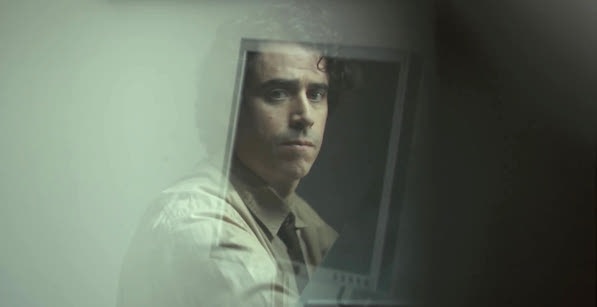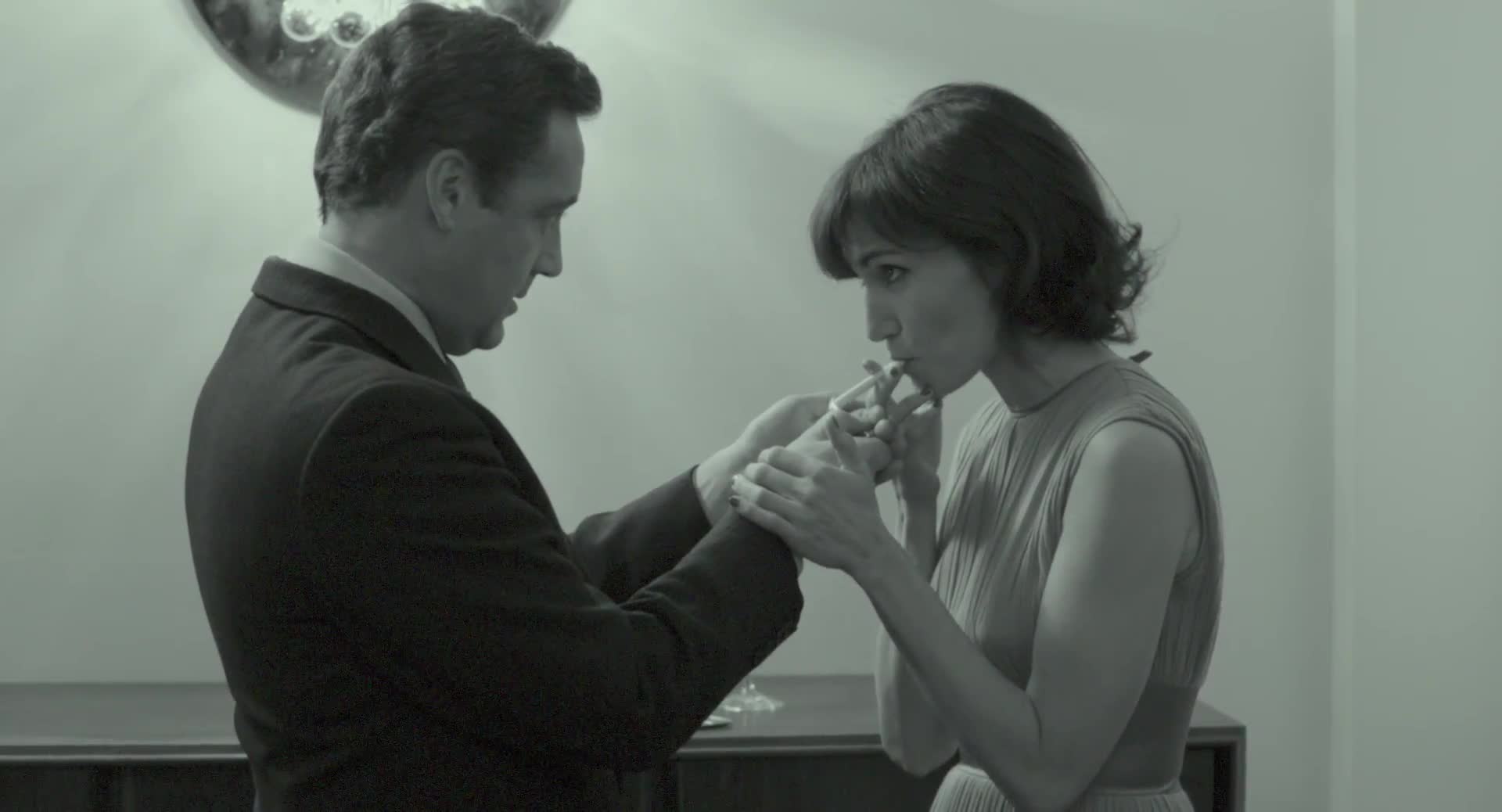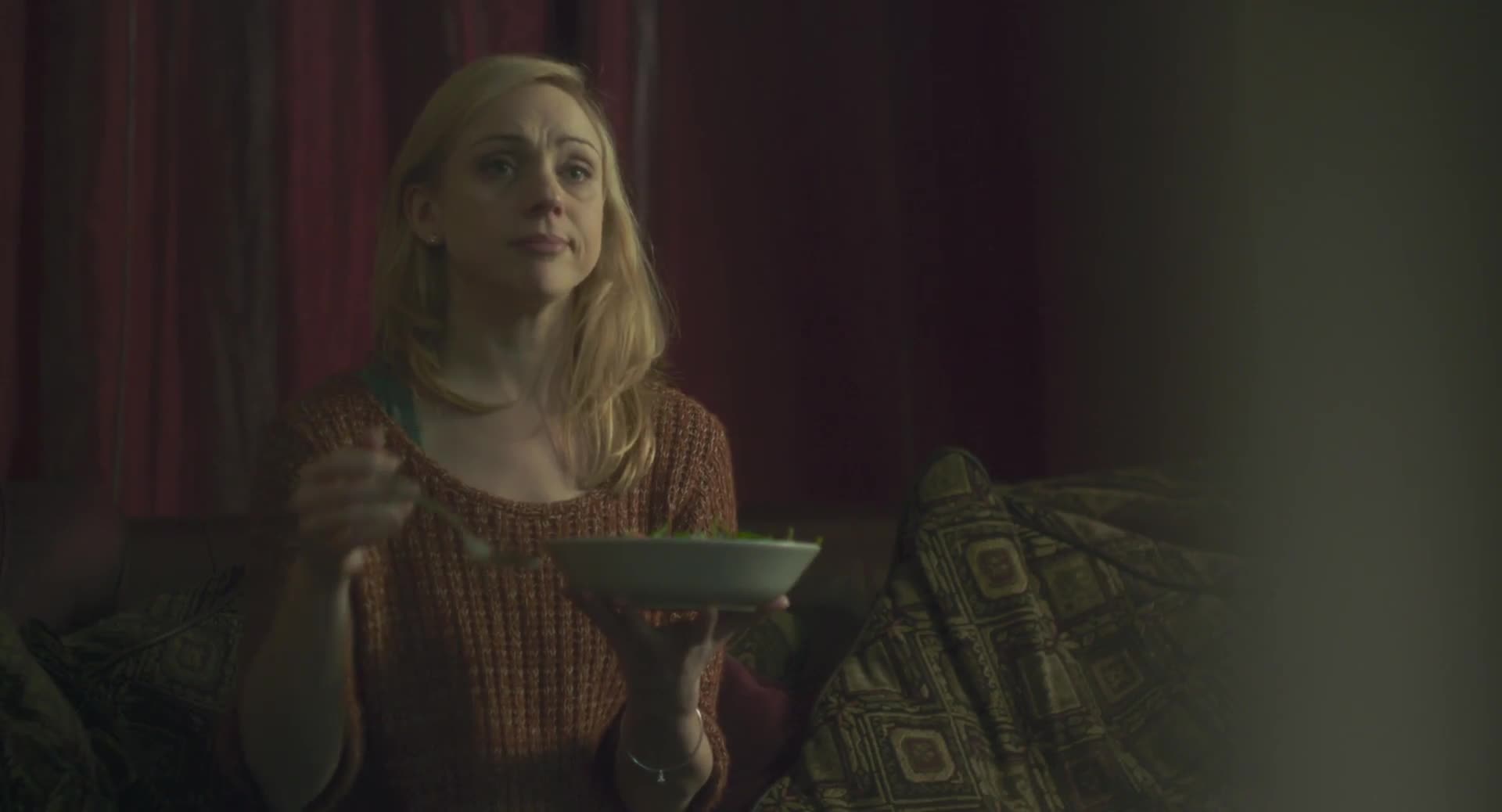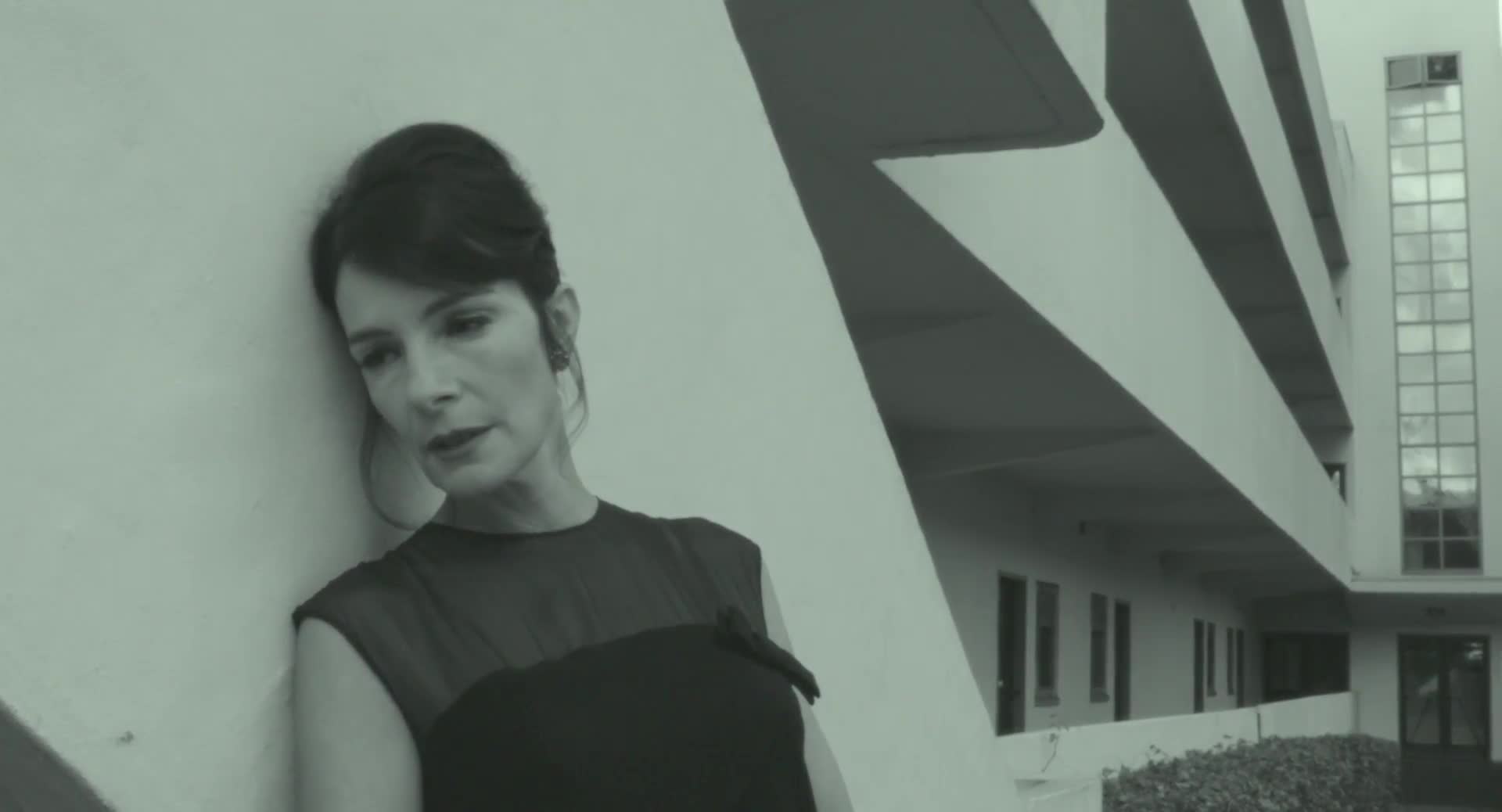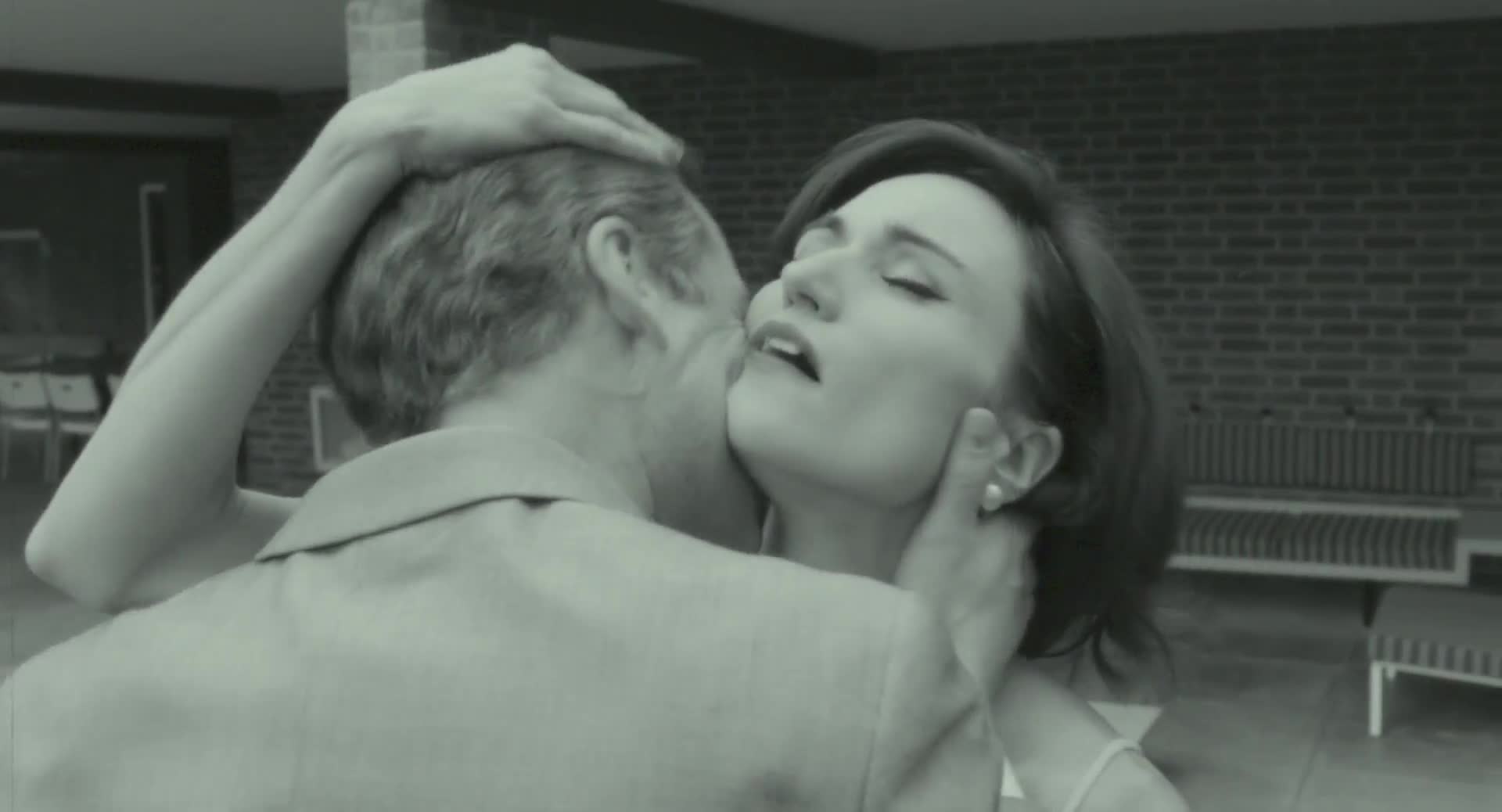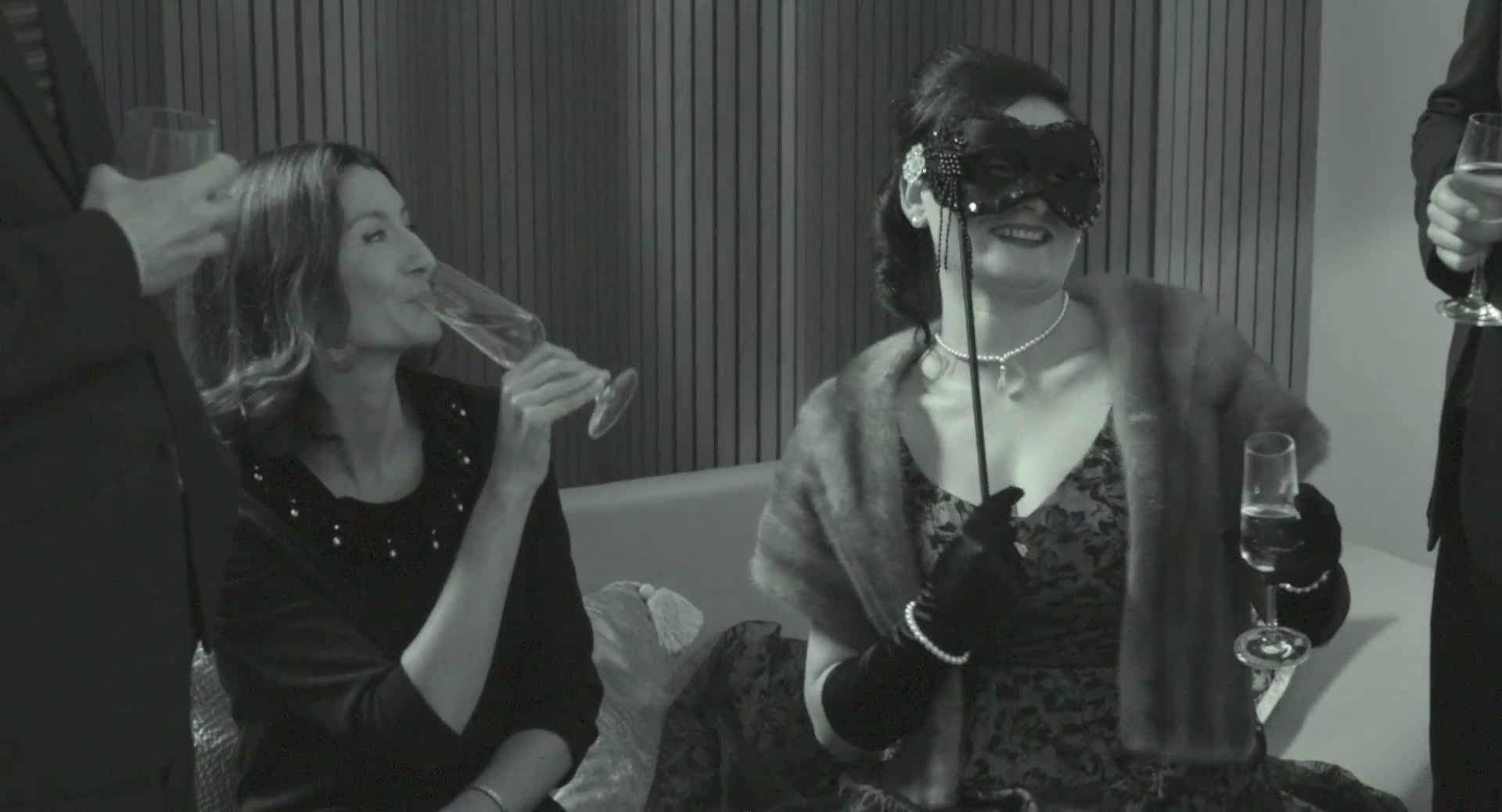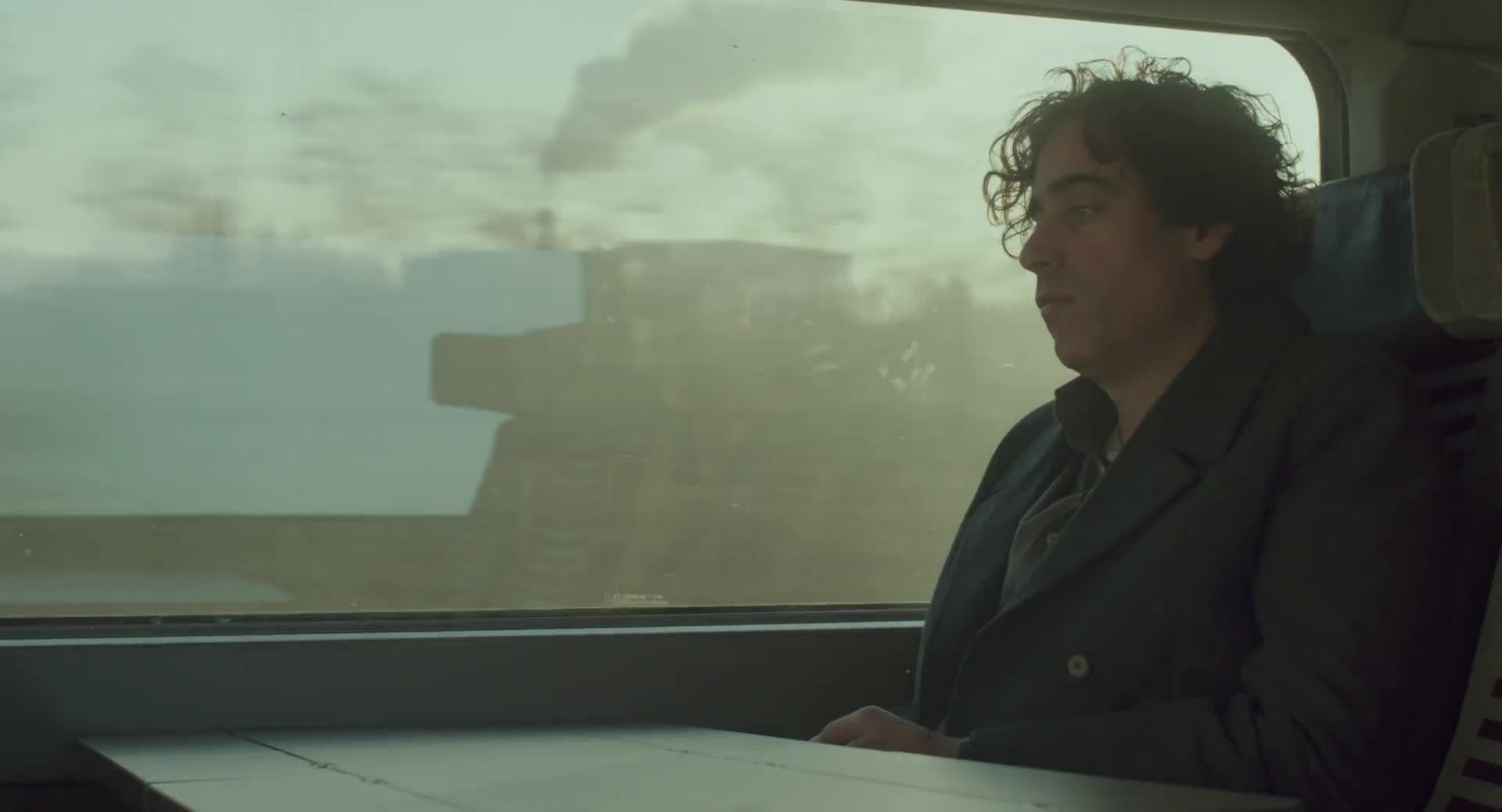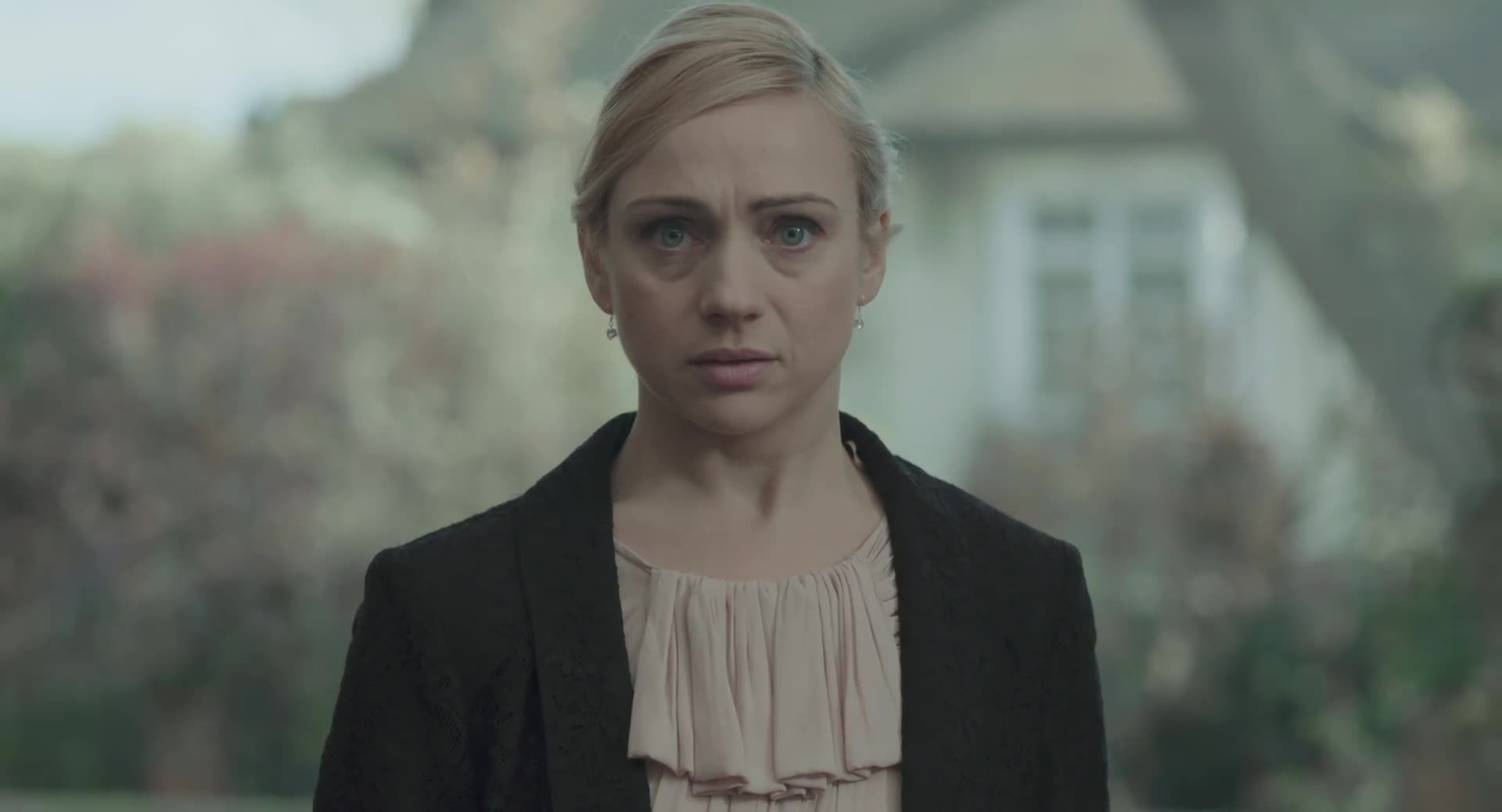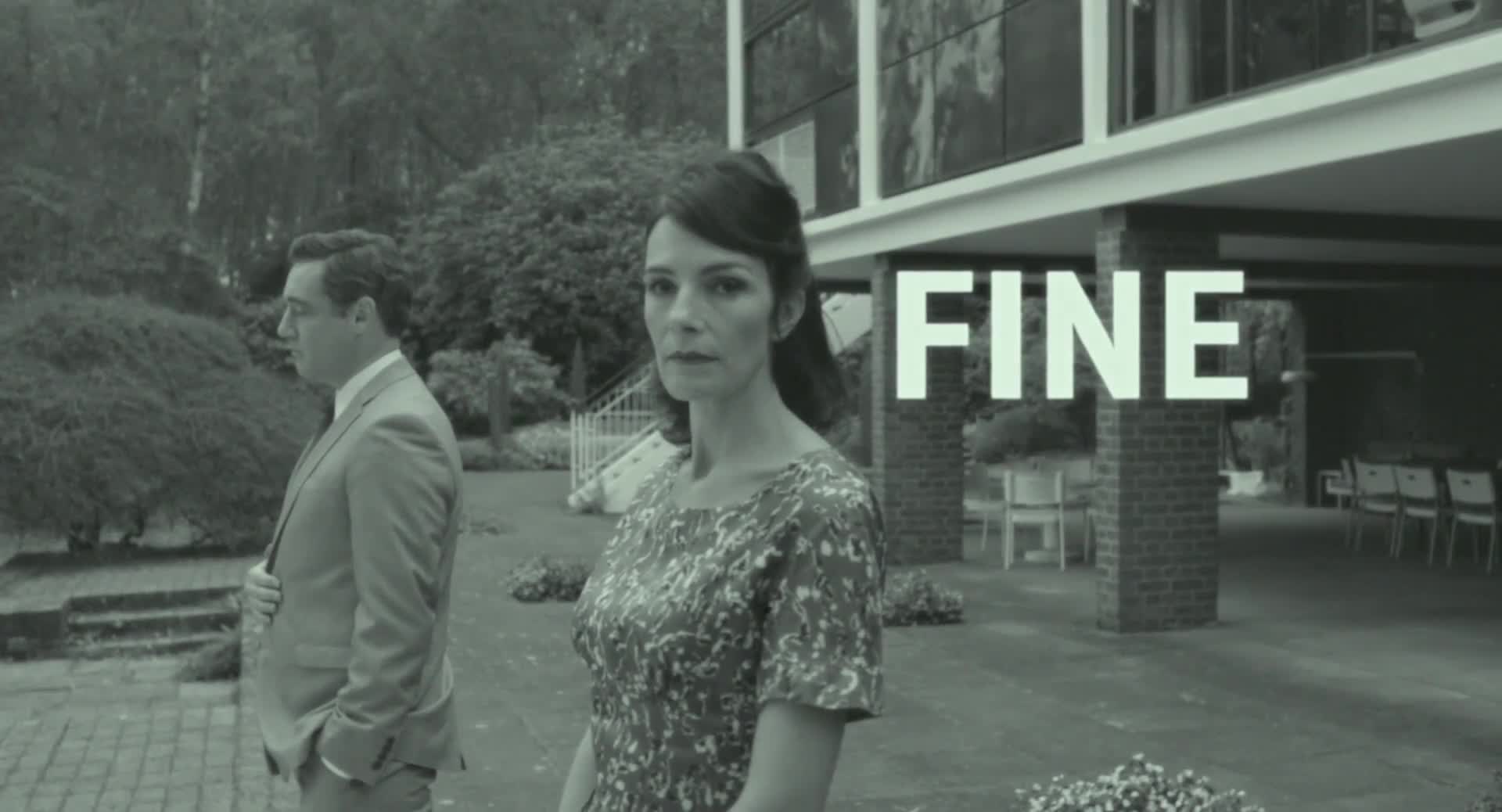Jonathan Romney is a film critic for FilmComment.com and a regular contributor to Sight & Sound, Screen International and other publications. He’s also a filmmaker and most recently he wrote and directed L’assenza, a twenty-minute short about an everyday guy named Martin (Stephen Mangan) who watches an obscure Italian film (called, of course, L’assenza—“The Absence”) and spots an extra who bears a remarkable resemblance to him. He laughs it off with a joke but curiosity becomes obsession and as he watches the film again and again, the ill-at-ease extra seems to become aware of Martin’s observations.
L’assenza applies a very low-key wit to the cinema of doubles and doppelgängers and drops it into the world of cinephilia, which adds a new angle on the themes of voyeurism and obsession. And Romney’s fake Italian movie, shot in creamy black and white and set to a jazz score plucked right out of the culture of pretentious elegance, is such a spot-on recreation of the cinema of sophisticated people and empty lives you’d swear it’s the real thing. “It sounds like it should be the Antonioni movie that got away,” remarked Romney in our long-distance conversation.
L’assenza made its world premiere at the 2013 New York Film Festival, played in festivals around the world, and was a nominee in the Short Film category for the 2013 British Independent Film Awards. I spoke with Jonathan Romney by phone (late night for him, early afternoon for me, thanks to the time difference between England and America’s West Coast) and communicated with producer Carey Born via email conversations.
Sean Axmaker: Filmmakers usually make short films when they can’t get a feature going or to show their talent, like a resume of sorts. What inspired you to make a short film?
Jonathan Romney: Everyone starts by making short films before they make features. And if you have an idea that is the right idea and self-contained and has its own logic, you may as well make it. I’m working on a feature at the moment but I’ve been saying to people, ‘There’s also this other short that I want to make.’ People are saying, ‘Do you really need to make a short at the moment? Shouldn’t you be working on a feature?’ But this other short had been nagging at me. Short ideas do have a way of coming to your consciousness fully formed and they demand to get out. I’d wanted to do this particular story for some time.
Axmaker: Tell me about First Born Films.
Carey Born: First Born Films is a production company that I co-founded. It’s based in London and produces European independent films. To date we’ve made shorts, but we’re now also launching into features with a documentary about cyborg-artist Neil Harbisson, and a drama from a best-selling Dutch novel for which we’ve just optioned the rights.
Axmaker: Carey, you are a writer & director in your own right. How did you get involved as a producer with L’assenza?
Born: I knew Jonathan Romney for a number of years. He pitched me L’assenza and I liked the idea so I asked him to send me the script. When I read it, it engaged me and made me laugh, but I also felt it contained a universal theme and a deeper meaning to do with projection, obsession and being consumed by the screen through a kind of narcissism, kind of relevant to our screen-obsessed lives today.
Axmaker: There is an interesting tradition of doppelgänger stories in the movies and in literature and, by coincidence, they became a thing last year when The Double and Enemy were released soon after your short made its film festival debut.
Romney: I know, and it was very strange. This one had been in the works for a while and it had already pretty much got made by the time I was aware of Enemy. The Double goes back to Dostoyevsky. I was a student of 19th-century literature so I was very aware of Dostoyevsky’s The Double and particularly Edgar Allan Poe’s William Wilson and I think that is the one that haunted me. Do you know that story?
Axmaker: Yes I do. Louis Malle directs a version of that story in the anthology film Spirits of the Dead.
Romney: Yes. It’s a very disturbing story because it’s by no means clear that William Wilson is the character’s double. They appear to be one and the same but are the same person or is he perceiving him in that way? One of the things in the doppelgänger tradition is the legend that if you see your double, you die on the spot, because there can’t be two of you in one world. I suppose I’m also interested in the idea that we all project into films in a particular way, we all stare at the screen and identify with characters and sometimes the person we identify with becomes stronger than us and we feel inferior to this ideal model that we have projected narcissistically into. The other source for this really is M.R. James, the great English supernatural writer, and he had this theme going throughout his work that was to do with people looking at engravings or paintings or books in which there was a drawing or painting and the figure would start moving. The image had a life of its own. So I think this story is deeply rooted in a tradition of nightmares.
Axmaker: The title of the film is bounced around for humor in the opening of the film, with Martin making fun of it—’The Absence. Absence of what? Absence of plot?’ I love his smart-ass comments because they sound familiar in the way they dismiss something that is difficult or unfamiliar without actually engaging with it.
Romney: The guy in this film has no interest whatsoever in Italian cinema and he doesn’t particularly want to watch an art movie on TV, he practically has to be forced into it. He’s completely resisting getting involved in this thing or showing any interest in it. I’m also aware that the movies I love and the people I know who love those films, we tend to make a joke of it. I’ve written about slow cinema in the past so when people say to me, ‘Oh yeah, you’re the guy obsessed with slow cinema,’ I make a joke of it and say, ‘Well I have a fascinatingly slow twenty-hour Bulgarian film that you really need to see.’ I suppose in a way one of the jokes of the film is at my own expense, my own obsession with a certain kind of film that a lot of people find unwatchable but means a lot to me. There was one very, very serious director of very, very slow films who looked me in the eye and said to me with an absolutely straight face, ‘Yes, of course, even I fall asleep in my own films.’
Axmaker: You’re not going to tell me who that is, are you?
Romney: I’m absolutely not, no.
Axmaker: There are two cinematographers listed in the credits, Nic Knowland, who shot Berberian Sound Studio and The Piano Tuner of Earthquakes, both of which have a cinephiliac quality that evokes other eras, and Tim Sidell. Did Knowland shoot the fake Italian sequences?
Romney: Yes. I knew him from the Quay Brothers films, I’ve been a huge fan of their films and he shot their live action films, and he also shot an extraordinary short called Je t’aime John Wayne (2001), that was a brilliant. I don’t know if you would call it a pastiche or a parody but it, let’s say, channels À bout de souffle very brilliantly in black and white, but it does it in London and it’s about someone in London living the early nouvelle vague dream, hopping on London busses and queueing outside cinemas. I loved the style of that and I knew that even though I was interested in something else, I was interested in something that really was a pure pastiche of an existing style. I knew that Nic would be brilliant at that sort of thing. The shoot was divided into two halves and it just kind of worked out that way because Nic was originally going to do the full film but, for various reasons, he couldn’t do the rest of it and the person who stepped in was a brilliant cinematographer named Tim Sidell who has a completely different style and a completely different take and it works brilliantly. It couldn’t have worked out better. It was two great DoPs instead of one and it’s magic.
Axmaker: L’assenza looks very expensive, thanks to the elegant backdrop of the Italian film. How did you find the locations?
Born: We couldn’t afford a location scout so I talked to architects and scoured books and the Internet for locations that wouldn’t be out of place in a film by Antonioni—something like the North Italian party villa in La Notte was what we were aiming for. I learnt a lot about modernist buildings in the South of England and we considered a number of locations including checking out a famous house called 2 Willow Road by the architect Erno Goldfinger (Ian Fleming apparently named his Goldfinger after him) but it was too small to shoot inside. We looked at another famous building called the ISOKON flats which we did use for the interiors of the Italian film and for one exterior shot too. But the great find was a beautiful house with extensive gardens outside London called The Homewood designed by Patrick Gwynne that is owned and run by the National Trust as a protected building. This is the ‘villa’ that features in the Italian L’assenza for almost all of the exterior shots: it was a bit of a coup that we were given permission to shoot there as the National Trust had not allowed any filming at The Homewood before. No doubt we were lucky with our locations, but I have to say the look of the Italian film is also very much down to the cinematographer Nic Knowland who knew exactly how to use the settings to create the backdrop.
Axmaker: I love that handsome, creamy B&W look, the elegantly-dressed society types against blank walls and wandering the empty outdoors, and that great modernist house of floating staircases and walls of windows.
Romney: The exterior of the two women standing by a wall and looking to the side, kind of hanging her head, is modeled very closely on a shot of Jeanne Moreau in Michelangelo Antonioni’s La Notte. That’s the most direct steal from La Notte but the film is very much modeled on La Notte. The reason I was fascinated with that film is I have a memory of seeing La Notte years ago on TV. I just remember by chance not even seeing the whole film but a large chunk of the party sequence and seeing these people dressed up beautifully and incredibly elegant and stylish at what looked like a great party but clearly having a miserable time. There’s something about people in evening dresses and tuxedos with champagne glasses in hand looking miserable. It’s such a kind of potent image. I guess there’s a touch of Marienbad in there as well.
Axmaker: Marienbad leads very nicely to one specific element of L’assenza. When Martin revisits the film, all the clips are repeated exactly the same except for the crowd scenes with the double. They get longer, they feature him more prominently—and then the camera follows him out of the shot.
Romney: My idea is that he emerges from the crowd and essentially becomes the star of the film. That double expands to fill the film, and then he’s gone.
Axmaker: It strikes me as an illustration of the way we can subjectively experience a film. We can focus on some aspect that specifically intrigues us and as we recall the film, that aspect dominates our impression of the film even though it was a small element.
Romney: I find myself writing about films sometimes and remembering lines and then I see the film again and the line isn’t even there. I’ve been writing about Jacques Tati‘s Playtime, which is a film you can see endlessly because you can never keep up with all the details. Someone said about it, and I think this is probably true of any film if you’re looking hard enough, that it’s not only a film you need to see several times but each time you need to see it from a different distance to the screen because you need to be looking at different part of the screen. So in a small way this is a version of that. Each time he sees the film, it’s slightly different, it’s like he’s absorbing the fact that he’s looking at it. It’s feeding off his look. And you could see that in a supernatural way or if you’re inclined to be more theoretical, you could apply that to the way we look at films anyway.
Axmaker: I want to praise the perfect soundtrack. The theme, an Eric Dolphy song called ‘Gazelloni,’ really captures the quality of an early sixties Italian art film: sophisticated and swinging yet just avant-garde enough to sound intellectual and a little distancing.
Romney: I was looking for something that would be right and I looked to see what records were actually released at that time. I knew the Eric Dolphy song, it’s from a classic album called ‘Out to Lunch.’ I also knew the slow piano and clarinet piece, which is by the Jimmy Giuffre Trio, and it’s around almost exactly the same time. Historically they both could have been in that kind of film and they completely fitted the mood. And then there’s a Wes Montgomery guitar piece which just felt right for the party scene. I was even thinking of a piece by Can at one point but historically it would have been wrong, it would have been at least nine years out. If it’s a sound that’s absolutely right you could have cheated and gone with music from any period but it just happened that you could get away with them from the point of view of historical accuracy.
Axmaker: What kind of commercial life do short films have?
Born: I think things are looking better for shorts these days. The Internet has certainly opened up opportunities—and not just for people to post and view shorts online for free. The problem of course is volume and selection: how do you know what to watch when there’s so much out there?
In terms of making films I believe it’s a matter of approach and, to some degree of following through. Certainly short form can help in learning one’s craft, but many filmmakers approach making a short film as a calling card that’s pretty disposable—you upload it, hope people will watch it, try to move on to features—rather than as a stand-alone piece of work with its own life, like a short story or a poem. If you approach making a short as a viable, self-contained piece of work and manage to create a buzz around it on the festival circuit and/or through social media, then there are a growing number of commercial options in terms of distribution. In the Far East people are increasingly downloading short films to watch on their devices while commuting to and from work. This is creating demand for shorts and for selective online platforms, and creating a revenue stream for filmmakers, which is great. I imagine this may be happening in the States now too. And I’m convinced this kind of demand will start to take off in Europe, if it hasn’t already.
Axmaker: One last question. One of the actresses in the Italian film is named Rebecca Cardinale. Any relation?
Romney: Not that I know of, but it kind of clicked beautifully, didn’t it, having a Cardinale in the film?

